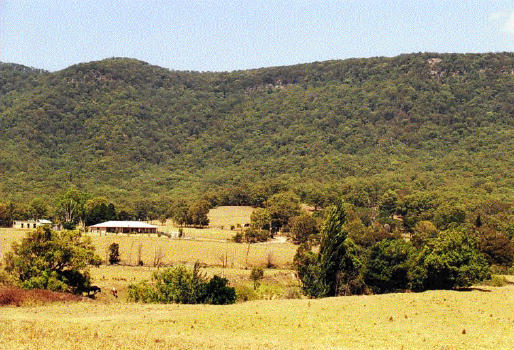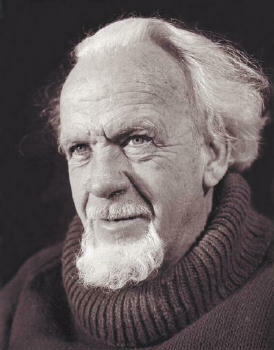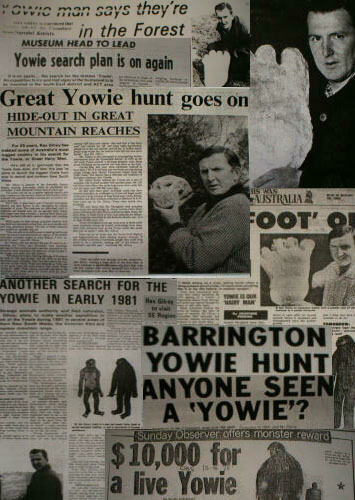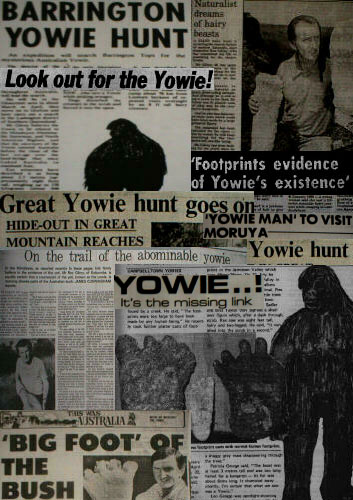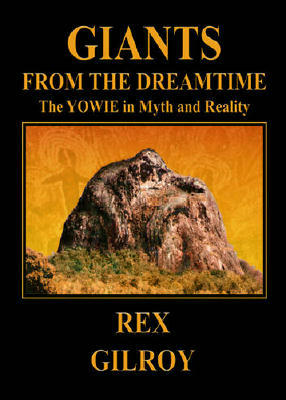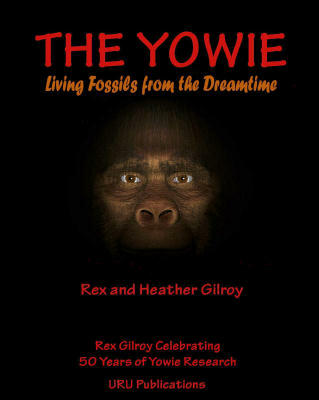Home Life Of The Yowie - How Many Yowies?
This article is composed of extracts from the 2007 book:
“The Yowie Mystery - Living Fossils From The Dreamtime".Copyright (c) 2007 Rex Gilroy, Uru Publications.
When the number of early European sightings reports are studied it is obvious that there were far more relict hominid sightings throughout the 19th and early 20th centuries than there are today.
The early European settlers first came to know about the “hairy people” from Aborigines they befriended and took the existence of these primitive people for granted, regarding them as another race with which the Aborigines had shared the continent. They also came to learn about pygmy-size beings and also giants that roamed the mountain forests of the western ranges.
As civilisation began to spread, in the wake of the land clearances, these primitive races retreated deep into the mountain country, where they apparently still reside. Yet as the 20th century wore on their numbers appear to have decreased, so that today, like the little pygmy folk, there are fewer sightings.
Giant beings are also occasionally encountered, but even these reports have decreased over the years. There can be no doubt that these relatives of Homo erectus proper, are gradually losing ground and will some day go the way of Australopithecus and the Neanderthals. Yet we still have time to learn more about these races, survivors from Australia’s Old Stone-Age who prefer to keep clear of the modern dominant species, Homo sapiens, for with our guns we are a greater threat to them than they ever were against themselves in their own Stone-Age conflicts.
When we discard the great many hoax reports and other unreliable evidence, we are left with a small amount of reliable material which shows that Australian relict hominids have been losing ground for quite some time.
So the question arises: Just how many relict hominids still survive in Australia?
This is a hard question to answer, particularly when either a single individual or even a small family group, might be reported seen by different eyewitnesses many kilometres apart as the hominids move from one place to another. Sometimes several separate reports of the same primitives will be made, giving the impression of a much larger local Yowie population for a given region than there really is. This example is also valid for sightings reports of pygmy-size Homo, as well as giant hominids.
If we concentrate upon certain areas of eastern Australia, chiefly the mountain ranges, we can arrive at a rough estimate which can be applied to the rest of the continent. For example, the Australian Yowie Research Centre, established by us at Katoomba back in the mid-1970s for the purpose of making a scientific investigation of the Australian relict hominid mystery, has been the scene of extensive research on the population issue, in the course of which the surviving regions of Yowie activity were pin-pointed.
From a study of all available campsites and recently manufactured implements it is possible to get some idea of approximate population figures for a given area. The Blue Mountains provide an excellent opportunity for these researches. In 2000 I began a study of apparent recently manufactured stone tools found over a wide area of the Blue Mountains. Out on Narrow Neck Plateau, which extends to the south-west of Katoomba Township, to overlook the Megalong Valley on its western side and the Burragorang Valley to its south, I collected a large number of apparent recently manufactured stone tools.
Primitive in their workmanship, they certainly compared with far older Homo erectus tool-types. In a few other rock shelter situations I came across small tools which could be said to be those of pygmy –size hominids. I have already described the creek that drops down from the Plateau into the Megalong Valley below, and which, since ancient times, has been used as an access to and from the summit by Stone-Age people. It is within this gully that traces of ancient, as well as more recent tool-makers have been found, as well as above upon the summit. Photograph right: Aboriginal Girl wearing a Kangaroo hide Garment. Photographer Unknown. I will credit anyone who owns this photograph.
It was above this gully outside a rock shelter in November 2000 that I uncovered a number of recently manufactured tools, consisting of both basalt and river pebble type. There were 27 in all, consisting of bone-smashing tools, scrapers and chopping implements. Yet as the types of stone were not local they had to have been transported up here from the valley.
One chopper measured 12cm in width by 6.3cm tall and 4.5cm thick. A grey basalt specimen, it was used to smash bones to obtain the marrow within. One scraping tool, made of a yellowish pebble and finely flaked around the cutting edge, was 6cm tall by 6.2cm width and 3cm thick. It would have been used for scraping animal hides among other uses. Most of the tools looked to be as recent as perhaps a few months old and their edges, some of which showed secondary chipping, looked as if they had hardly been used. In fact, I had the feeling that these tools had been left by someone who intended to return at some stage. Perhaps ‘he’ or ‘they’ had returned to the valley. Stone tools are far more abundant than human bones and cover the Australian landscape.
Apart from the more recent Aboriginal specimens, there are the Eolithic implements of our ‘unknown’ Old Stone-Age which, to those like myself with a keen eye capable of singling these tools out from all the other rocks on the ground, can tell us much about our primitive ancestors daily lives. Indeed, we can learn a lot more about our ancestors from the tools that they made than by just studying their fossil remains. As stone tools in particular often outlast the fossil remains of their maker, they are more useful indicators of the former presence of Stone-Age man. During his lifetime a Homo erectus hunter would manufacture perhaps thousands of Palaeolithic stone implements. These tools provide us with an insight into the daily cultural life of the people of early Pleistocene times.
The techniques of tool-making were handed down from generation to generation, and sequences of techniques indicate cultural lines. American anthropologist, the late Dr. Carleton S.Coon noted that “when two groups of people whose territories have common borders are found to have made similar tools, we may infer that one group taught the techniques to the other, with an added likelihood of gene flow between them. Conversely, when two lines of tool-making follow similar evolutionary paths, although they are widely separated in space, the possibility of independent invention and parallel cultural change must be considered”. [P32, “The Origin of Races” 1968, Jonathan Cape].
It would appear that the same Homo erectus styles have been carried on into modern times among our living relict hominids, as can be observed by comparing many recently made tools with their Palaeolithic counterparts. A study of the tools imported to the summit of Narrow Neck Plateau from the Megalong Valley tell us something of their origin, for they were manufactured from stones to be found principally at the southern end of the valley behind Packsaddlers and on into the Burragorang valley, suggesting that a reasonable, if small population of perhaps 30 to 50 or more people could be moving about those remote wilds in small family groups.
Much farther away across the Burragorang, the Kanangra Boyd National Park has been the scene, not only of numerous sightings over the years, but also discoveries of quite recent tools of chert, quartz and basalt that appear to have originated from outside this area, that is from the Burragorang Valley to the east of the Kanangra Plateau or else the country to the west. It could be that, based upon the gathered evidence, that a population of, around 60 Yowie/Homo erectus hominids share these wilds with about the same number, perhaps more, of their pygmy Homo erectus form. The above approximate figures could be given for the Wollongambie-Wollemi-Newnes wilderness region north of the Grose Valley, where there have been many sightings claims and eerie encounters with these relict hominids over the years.
It was while on a search of the Newnes Forest country on Wednesday 21st July 2004 with Heather and another assistant of ours, Mark Conyard, that I came across two small campfires composed of fine ash, reminiscent of a typical Aboriginal campfire. These campfires were within close proximity of one another and only a few weeks old, suggesting up to several individuals had camped here. As marsupial life is plentiful in these wilds it would be a profitable hunting ground for any living Stone-Age hominids. Lately the rugged country to the south of Lawson, which lies east of Katoomba, has emerged as the possible location of a well-hidden camp of Homo erectus/Yowie, probably situated in an out-of-the-way, well hidden and densely forested gully, because of the number of apparent recently flaked stone tools that have been recovered from a particular area thereabouts by me.
These tools, from more than one location behind the township, appear to vary from a few months to perhaps a few weeks old. Some display retouching of the cutting edges. At a guarded estimate I believe it is possible that a group of about a dozen adults and also probably children occupy the aforementioned camp. If we include the entire mountainous region extending from the Burragorang-Kanangra, northwards through the Megalong-Jamieson Valleys and Katoomba and on to the Wollemi-Newnes region and probably including Glen Davis as well; at a guarded estimate we might be dealing with around 600 relict hominids other than the pygmy population, which might not be all that far behind this approximate figure.
These estimates could probably be applied to the New South Wales south coastal mountain ranges and on into the Snowy Mountains region. They could certainly be applied to the ranges to the north of the Hunter Valley, such as the Mt Royal Range-Barrington Tops area and on up through the Nundle, Taree, and Kempsey-Carrai Range towards Coffs Harbour and inland from there. Yet here we are dealing with some truly inaccessible terrain where any number of primitive hominids, pygmy and otherwise, could roam in peace and in perhaps larger numbers than suspected. The border ranges still have a rich ‘hairy man’ folklore and possibly a reasonable number of pygmy beings and also some of their larger relatives continue to roam these jungles, as some interesting sightings claims and footprint discoveries could suggest.
The numbers suggested for the Blue Mountains region could perhaps be applied for the mountain country which, beginning near Mackay, continues on to the Atherton Range-Cape York. We can only speculate and make guarded population estimates based upon what evidence we have.
“The Yowie Mystery - Living Fossils From The Dreamtime".
“The Yowie Mystery - Living Fossils From The Dreamtime". Special Dedication. The Authors dedicate this book to the late Charles Melbourne Ward F.Z.S.; F.R.Z.S. known to his great many friends simply as ‘Mel’. Together with his wife Halley, he operated a natural history museum in the grounds of the Hydro Majestic Hotel at Medlow Bath for many years and also another established at Echo Point, Katoomba. It was ‘Mel’ who first taught me how to collect, record and study natural history specimens, beginning when I was aged 11 years old on holidays with my parents at Katoomba in 1954. Thereafter, every school holidays spent in Katoomba began with a visit to ‘Mel’ at his Medlow Bath Museum to inform him how my fledgling natural science studies were progressing!
As a result and after my parents moved from our Lansvale [western Sydney] home to Katoomba, the Gilroys and Wards became close friends. There was hardly a week which did not see me peddling my pushbike from our North Katoomba home up the Great Western Highway to see ‘Mel’ at his museum for more instruction. Mel Ward possessed a wide knowledge of the culture of the Australian Aborigines and that of the former local Blue Mountains tribes in particular.
He was also a firm believer in the “Hairy Man” and supported my researches in this regard. At my 21st birthday party, held at the Homesdale Function Centre, at Katoomba on Saturday night 8th November 1964, I well recall how my old friend, in front of a large gathering, congratulated me on my researches and the large natural science collection that I was forming and then said: “You’ve done a fantastic job Rex, BUT IT’S ABOUT TIME THAT YOU STARTED MAKING SOME BLOODY MONEY OUT OF IT” in a loud voice that brought the house down!
That following week, together with my father Mr W.F. [Bill] Gilroy, I began a search of local venues, which soon resulted in the acquisition of the lease from the Blue Mountains City Council of the Mt York Tea Rooms, outside Mt Victoria, the rest they as “is history”. Two years late, on October 6th 1966, Mel Ward was dead, having passed away in his sleep. He once said to my father that I was “the Mel Ward of Tomorrow” and I am certain that Mel would be pleased to know that I have indeed followed in his footsteps.
Mel led an adventurous life. The son of Hugh J. Ward, a famous Shakespearean actor of the early 20th century, Mel was encouraged to go on the stage by his father but Mel developed a passion for the natural sciences and his wealthy parents helped him become established. In his lifetime of achievement, Mel became recognised as a world authority on Crustaceans and an anthropologist. He was made a Fellow of the Royal Zoological Society of New South Wales and was pleased when I too became a member of the Society in 1963. He encouraged me, not long before his death, to take on the Presidency of the Society’s Entomological section, where I served for three years from 1966 to 1969.
That he achieved so many things in the course of his lifetime researches is remarkable, because like this author, he was an amateur with not one university degree to his name! I am certain that my old friend would be delighted at the fact that, together with heather, I am now writing and publishing book on the subjects he loved and on the Yowie in particular. He taught me never to blindly follow the textbook and dare to question dogmas and not be told what to think! I have certainly followed his advice. Knowing Mel Ward as I did I know he would wholeheartedly approve of the scientific approach of this book, therefore “Mel”
This Book is for You!
Rex Gilroy - Australian Yowie Research Centre, Katoomba, NSW.
Monday 25th June 2007I also present sensible advice to any future would-be Yowie investigators. The reader will also be awed at the great many discoveries my wife Heather and I have made in all our years together in the field. I feel privileged to be the founder of Yowie research and to have encouraged other, sensible researchers to follow my example. The search for surviving relict hominids in remote, hidden regions of the world, has been called the “last great search”, and it is both a fascinating and exciting one. Rex Gilroy may be contacted at the Australalian Yowie Research Centre, PO Box 202, Katoomba. NSW 2780. Ph 02 4782 3441 or email New Email Address as of June 2009 randhgilroy44@bigpond.com on or visit our website : http://www.mysteriousaustralia.com/ or http://www.australianyowieresearchcentre.com/ or http://www.rexgilroy.com/
Newspaper Articles on Rex Gilroy's Lifetime Search for the Australian Yowie
Newspaper Articles on Rex Gilroy's Lifetime Search for the Australian Yowie
Aboriginal/Koori Names for the Australian Yowie
To present the Yowie mystery in its proper context, relict hominid evidence from south-east Asia, New Guinea, other west Pacific Islands and New Zealand is revealed, demonstrating how the ancestors of these ‘manimals’ once spread out across the earth via land-bridges that formerly joined Australia/New Guinea/New Zealand with what is now island south-east Asia to the Asian mainland.
“Hairy man” was a name given by the Aborigines to any non-Aboriginal race with which they shared this continent, but the term centred primarily upon at least three basic forms. These forms were either the height of an average human being, an enormous man-like and also ape-like form. All were known by different names Australia-wide, but all meant either “hairy man” or “great hairy man”.
